The Golden Dawn or Thoth Method
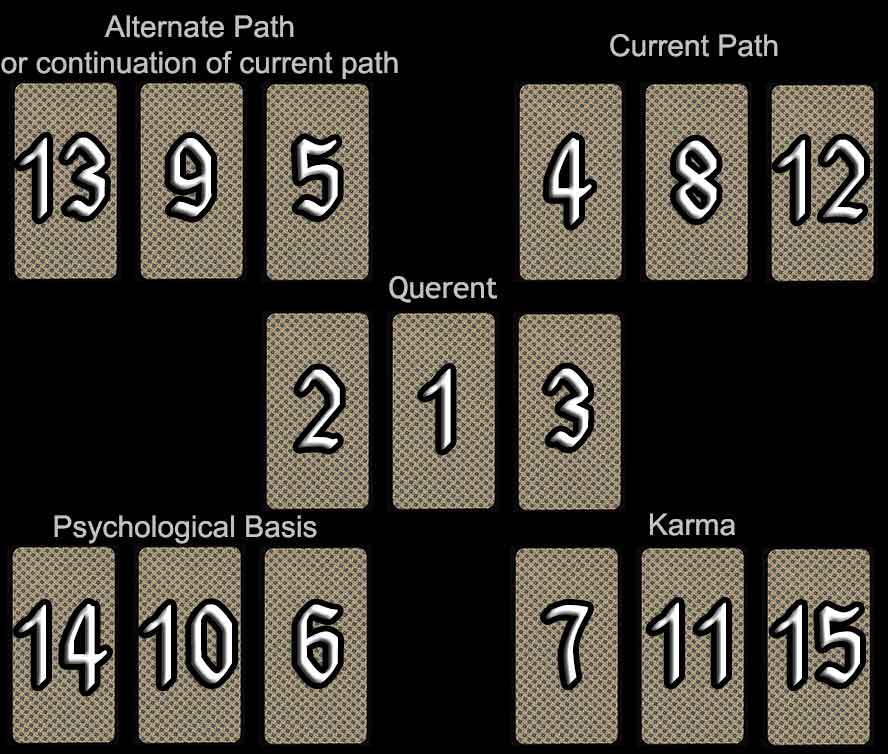
Difficulty: Complicated
Note: Tarot decks that use reversed cards such as the Rider-Waite do not work well with this spread, which was designed to be read using elemental dignity.
The Golden Dawn spread is best suited for use with the bifrost Tarot and especially the Book of Thoth, as these decks are meant to be read a certain way with the court cards. Princes and queens represent actual men and women connected with the matter, while princesses generally represent ideas; thoughts or opinions, and knights represent arrival or departure of a matter depending on the direction faced.
In this tarot spread, particular attention should be paid to a card's exact position in relation to its neighbours. Whether the neighbour cards bear the same energy (suit) determines whether a card is considered well-dignified or ill-dignified. Opposite suits ill-dignify each other, while other suits are considered friendly. Tarot cards of the same suit or element strengthen each other.
As with other tarot spreads, it is important to count the cards' tendencies, such as whether there is a lot of one particular suit or number pattern. The patterns reveal special messages. Having several majors present indicates higher forces at work, several cups suggest strong emotions, etc.
Card #1 represents the reader and the nature of the topic at hand.
Cards #2 & #3 are read in extension of #1 to further comprehend the nature of the topic.
The two sets of three tarot cards at the top of the spread represent chronological sets of events. The current path as it would unfold naturally is represented by cards #4, #8, & #12. The alternate path that could be taken is represented by cards #13, #9, & #5. However, if the reader gets the feeling these cards are telling them they go together, then the alternate path is to be considered an extension of the current path, and to be read chronologically in this order: #4, #8, #12, #13, #9, #5. Just keep in mind: this is only if the two paths seem particularly similar.
Cards #14, #10, & #6 shed light upon the psychological undertones of the current issue.
Cards #7, #11, & #15 represent the influences of karma and destiny beyond the reader's control. These cards suggest adapting to this, as fate.
Your Golden Dawn Reading
| The Alternate Path (or Extension of Current Path) |
Your Current Path |
|||||
The Devil (Le Diable) |
Ace of Cups |
The Magician (Le Bateleur) |
Ten of Cups |
Seven of Swords |
Deuce of Swords |
|
| The Querent | ||||||
The Moon (La Lune) |
Six of Coins |
Deuce of Coins |
||||
| The Psychological Basis | Karma | |||||
The Chariot (Le Chariot) |
Four of Batons |
Five of Cups |
King of Coins |
King of Swords |
The Star (L'Étoile) |
|
The Querent
cards represent the querent and the nature of the topic at hand. The first card (in the center of the spread) represents the very core of the matter, and the other two cards around it are added to it in order to further comprehend the nature of the topic.
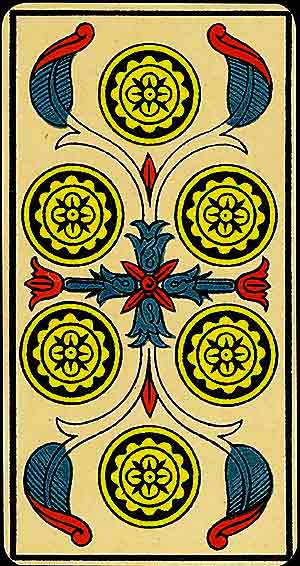
Symbolism:
Six coins are symmetrically arranged, often accompanied by flourishing floral motifs, suggesting harmony and generosity. The design reflects themes of giving and receiving, balance in material matters, and acts of kindness.
Meaning:
The Six of Coins represents generosity, charity, and the balance of give and take. It speaks to the distribution of wealth, whether material or spiritual, and suggests that sharing one's resources can bring rewards. This card also highlights the importance of fairness and balance, indicating that help will be returned when it is needed.
In relationships, it emphasises mutual support, equity, and the importance of both giving and receiving. Spiritually, it encourages a generous heart and the understanding that true wealth comes from shared abundance.
Keywords:
Generosity, charity, balance, fairness, reciprocity, wealth, giving, receiving, support, compassion.

(La Lune)
Symbolism:
The Moon hangs high in the sky, casting a dim, mysterious light over a landscape. A dog and a wolf howl at the moon, representing instincts and the untamed subconscious. A pool sits between two towers, suggesting the unknown. A crayfish crawls out of it, symbolising hidden emotions emerging.
Meaning:
The Moon represents intuition, mystery, and the subconscious. It suggests a time of uncertainty where not everything is as it seems. This card invites you to trust your instincts and explore hidden depths. It also warns against illusion or confusion, urging clarity.
In relationships, it can indicate emotional complexity or hidden dynamics. Spiritually, it calls for embracing intuition and the mysteries of the psyche.
Keywords:
Intuition, mystery, subconscious, illusion, uncertainty, emotions, dreams, instincts, exploration, hidden truths.
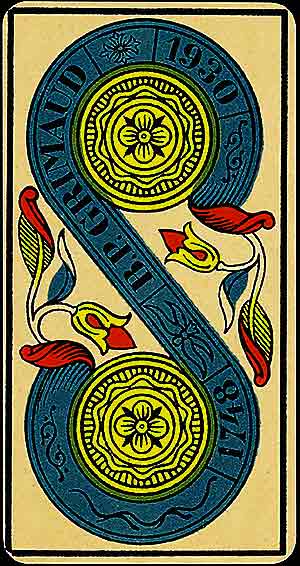
Symbolism:
Two coins are positioned symmetrically, often linked by a ribbon or floral decoration, suggesting balance and flow. The design reflects themes of adaptability, resource management, and the harmonious juggling of priorities.
Meaning:
The Two of Coins symbolises balance and adaptability. It speaks to juggling multiple priorities or resources, and the ability to maintain equilibrium in a time of change. This card encourages flexibility in managing material or financial matters, as well as maintaining a healthy balance between work and personal life.
In relationships, it may indicate the need for balance between personal and professional responsibilities. Spiritually, it represents the flow of energy and learning how to maintain harmony amid life's challenges.
Keywords:
Balance, adaptability, flexibility, duality, priorities, change, harmony, juggling, management, resourcefulness.
Your Current Path
cards represent your current path as it would unfold naturally. These cards are read in chronological order from left to right.

Symbolism:
Ten cups create a vibrant, overflowing arrangement, often adorned with lush flowers or intricate patterns, radiating harmony and joy. The image conveys the pinnacle of emotional achievement, lasting happiness, and the fulfilment of familial or communal bonds.
Meaning:
The Ten of Cups represents ultimate emotional fulfilment, family harmony, and a deep sense of belonging. It is the pinnacle of emotional achievement, signifying lasting happiness, unconditional love, and shared joy.
In relationships, it reflects a profound and harmonious bond. Spiritually, it represents alignment with universal love and the interconnectedness of all things.
Keywords:
Happiness, fulfilment, harmony, family, love, community, connection, gratitude, abundance, shared joy, emotional success.

Symbolism:
Seven swords are arranged in a slightly chaotic or uneven configuration, emphasising complexity and strategy. The design suggests themes of cunning, deception, and the need for careful planning.
Meaning:
The Seven of Swords represents strategy, deception, or avoiding confrontation. It suggests a need to act carefully, but warns against dishonesty or taking shortcuts. This card encourages cleverness but with integrity.
In relationships, it may indicate secrecy or mistrust. Spiritually, it suggests the importance of facing the truth rather than evading it.
Keywords:
Strategy, cunning, deception, avoidance, stealth, dishonesty, planning, mistrust, cleverness, truth-seeking.
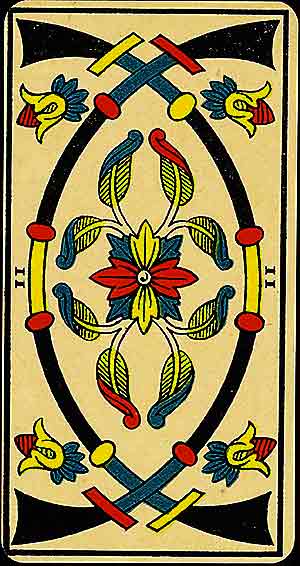
Symbolism:
Two crossed swords create a balanced yet tense composition, often adorned with small floral elements to soften the imagery. The card suggests duality, decision-making, and the need to find equilibrium amidst opposing forces.
Meaning:
The Two of Swords represents a choice or dilemma requiring balance and thought. It suggests being caught between opposing forces or avoiding a decision. This card encourages you to confront the truth and rely on logic and intuition to find resolution.
In relationships, it highlights communication blockages or an emotional impasse. Spiritually, it urges you to find balance within opposing energies.
Keywords:
Indecision, stalemate, balance, choice, reflection, mental conflict, neutrality, avoidance, logic, resolution.
The Alternate Path
cards represent the alternate path that you could choose to take in lieu of the Current Path. However, if the cards that come up seem to indicate that they go along with the Current Path, these three cards should be interpretted not as an Alternate Path, but as a chronological extension of the Current Path (also read from left to right).
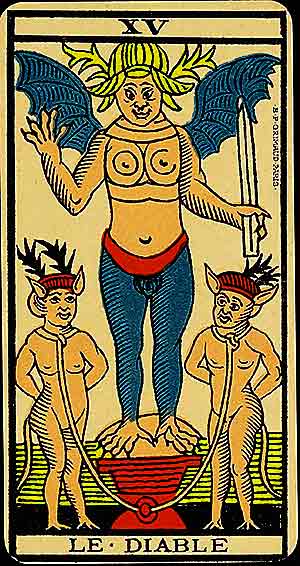
(Le Diable)
Symbolism:
The Devil is portrayed as a horned figure with two chained human figures below, representing bondage to materialism or desires. The chains are loose, suggesting self-imposed limitations. Their animalistic features symbolise the materialism and polarity of nature.
Meaning:
The Devil represents temptation, materialism, and the shadow side of human nature. It highlights unhealthy attachments, addictions, or fears that may be holding you back. This card calls for awareness and the courage to break free from self-imposed limitations.
In relationships, it warns of codependency or power imbalances. Spiritually, the Devil challenges you to confront and integrate your shadow self.
Keywords:
Temptation, bondage, materialism, addiction, fear, control, power, shadow self, self-awareness, liberation.

Symbolism:
A single, ornate cup stands at the centre, often crowned with a flowing fountain or delicate embellishments, symbolising abundance and divine inspiration. The card radiates themes of emotional renewal, spiritual connection, and the beginning of fulfilling relationships.
Meaning:
The Ace of Cups represents emotional abundance, new beginnings in relationships, and the outpouring of love and compassion. It signals the birth of deep emotional connections, healing, and a time to open your heart to joy and creativity. This card encourages you to embrace vulnerability and allow emotions to flow freely.
In relationships, it signifies profound intimacy and love. Spiritually, it symbolises divine inspiration and the awakening of the soul to universal love.
Keywords:
Love, new beginnings, emotional abundance, compassion, intimacy, healing, joy, vulnerability, creativity, spiritual awakening.
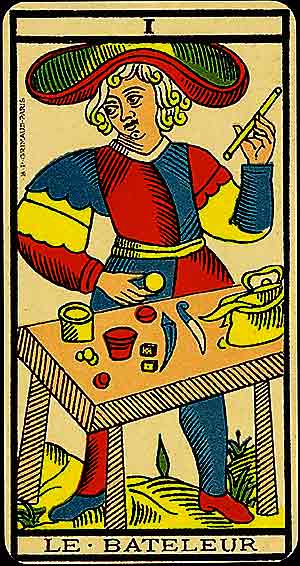
(Le Bateleur)
Symbolism:
The Magician is a youthful figure standing behind a table, holding a wand aloft while other tools lie before him—often a coin, a cup, and a sword. These tools represent mastery over the elements and the power to manifest intentions. His hat, shaped like a lemniscate, symbolises infinite potential, and his posture suggests readiness and action. The vibrant colours of his attire evoke creativity, energy, and a zest for life.
Meaning:
The Magician represents the power of initiative, skill, and resourcefulness. He embodies the ability to turn ideas into reality, combining intellect, action, and willpower. The card often signals the beginning of a new venture or opportunity, where focus and confidence are key. However, it also serves as a warning to avoid manipulation or overconfidence.
The Magician invites you to be aware of your tools and talents, urging you to act with intention. It also reminds you that success depends on your ability to harmonise thought and action.
Keywords:
Initiative, manifestation, skill, potential, confidence, willpower, beginnings, resourcefulness, action, focus.
The Psychological Basis
cards shed light upon the psychological undertones of the current problem.
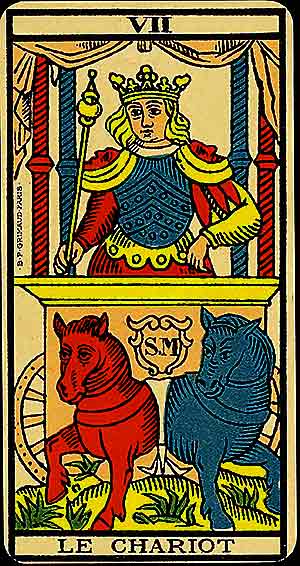
(Le Chariot)
Symbolism:
The Chariot shows a warrior standing in a chariot pulled by two horses of contrasting colors, symbolising opposing forces. The warrior wears a crown and holds a wand or reins, signifying control and determination. The canopy above him suggests moving forward from a place of stability into the unknown.
Meaning:
The Chariot signifies triumph through determination, discipline, and focus. It speaks to mastering conflicting forces and steering your life toward success. This card often appears when you are on the brink of achieving a goal, but it reminds you that persistence and self-control are essential.
In relationships, the Chariot suggests navigating challenges together. Spiritually, it emphasises aligning your willpower with your higher purpose.
Keywords:
Triumph, determination, focus, control, discipline, victory, mastery, momentum, perseverance, alignment.
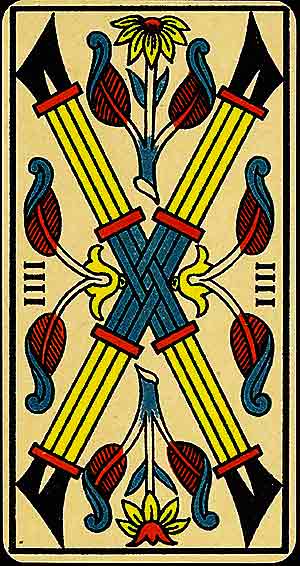
Symbolism:
Four batons form a stable, rectangular frame adorned with budding leaves, signifying balance and structure. This card represents a foundation of support and a sense of accomplishment in one's endeavours.
Meaning:
The Four of Batons represents celebration, stability, and harmony. It marks a time to pause and appreciate achievements or milestones. This card often symbolises community, shared joy, and the fulfilment of goals.
In relationships, it indicates harmony, commitment, or joyful gatherings. Spiritually, it reflects alignment with your surroundings and a sense of belonging.
Keywords:
Celebration, harmony, stability, joy, milestones, unity, achievement, community, gratitude, fulfilment.

Symbolism:
Five cups create a loose arrangement, with floral and vine motifs adding a touch of complexity, symbolising emotional shifts. This card evokes themes of loss or disappointment but hints at remaining opportunities and growth.
Meaning:
The Five of Cups represents loss, regret, and the pain of emotional setbacks. However, it also emphasises the potential for healing and moving forward. It urges you to focus on what remains rather than what has been lost.
In relationships, it suggests unresolved issues or the need to address emotional wounds. Spiritually, it reflects the transformative power of grief and the journey toward acceptance and renewal.
Keywords:
Loss, regret, grief, healing, perspective, emotional setbacks, recovery, acceptance, moving forward, transformation.
Karma
These cards represent the influences of karma and destiny that are beyond your control. They suggest adapting to this fate.
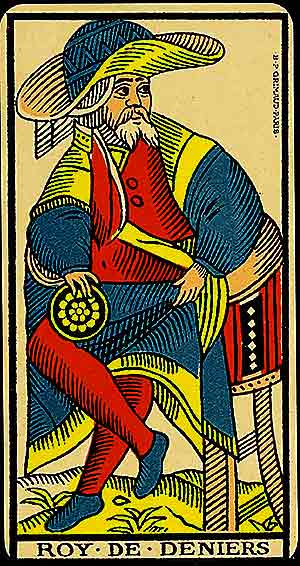
Symbolism:
The Roy of Coins is a regal figure seated on a throne, holding a coin casually, conveying wealth and stability. This card embodies mastery over material resources, leadership in financial matters, and the wisdom to build and sustain long-term success.
Meaning:
The King of Coins represents mastery over the material world. He embodies financial security, success, and the ability to manage wealth and resources effectively. This card signifies achievement and stability, as well as the wisdom that comes with long-term success.
In relationships, it suggests a reliable, prosperous partner who offers security and stability. Spiritually, it reflects the mastery of the material world and the ability to use wealth for the benefit of both oneself and others.
Keywords:
Mastery, wealth, financial security, success, stability, resources, prosperity, achievement, leadership, responsibility.
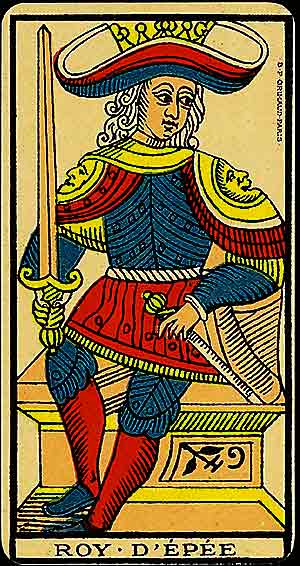
Symbolism:
The Roy of Swords sits on a grand throne, gripping a sword with authority, surrounded by minimal decoration to emphasise his focus and intellect. This card represents mastery of logic, clear judgment, and leadership in matters requiring mental precision and fairness.
Meaning:
The King of Swords represents authority, logic, and ethical leadership. He advises using intellect and fairness to make decisions. This card encourages seeking truth and upholding moral integrity.
In relationships, it suggests rational communication and mutual respect. Spiritually, it represents mastery of the mind and the power of clear thought.
Keywords:
Authority, logic, truth, judgment, fairness, intellect, leadership, integrity, clarity, rationality.
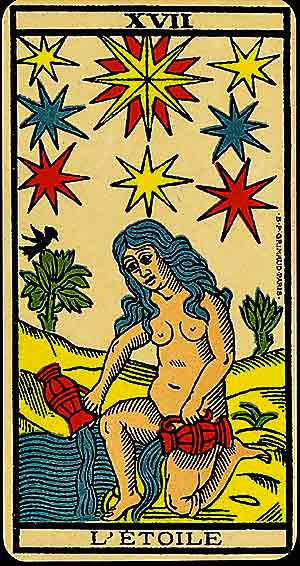
(L'Étoile)
Symbolism:
A nude female kneels by a stream, pouring water onto the earth and back into the water, symbolising renewal and flow. Above her, stars shine brightly, representing hope and divine guidance. A bird perched in a tree or nearby adds an air of peace and harmony. The scene exudes serenity and openness.
Meaning:
The Star symbolises hope, inspiration, and renewal. It reminds you to trust in the universe and your own potential. This card often appears after a challenging period, offering reassurance and a sense of peace. It encourages vulnerability and faith in the future.
In relationships, it signifies harmony and healing. Spiritually, the Star points to alignment with your higher purpose and divine inspiration.
Keywords:
Hope, inspiration, renewal, peace, faith, healing, guidance, openness, vulnerability, harmony.
